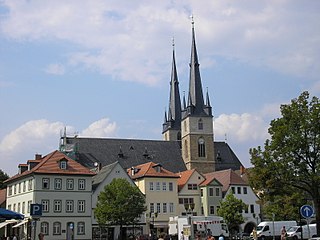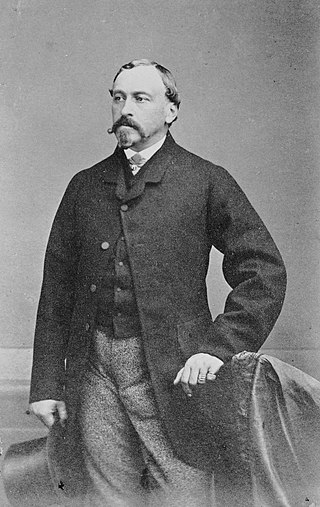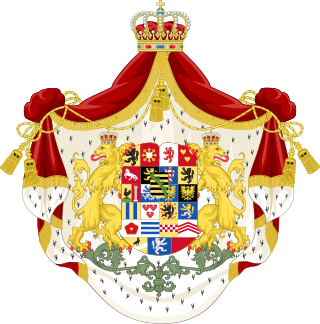
George Hamilton-Gordon, 4th Earl of Aberdeen,, styled Lord Haddo from 1791 to 1801, was a British statesman, diplomat and landowner, successively a Tory, Conservative and Peelite politician and specialist in foreign affairs. He served as Prime Minister from 1852 until 1855 in a coalition between the Whigs and Peelites, with Radical and Irish support. The Aberdeen ministry was filled with powerful and talented politicians, whom Aberdeen was largely unable to control and direct. Despite his trying to avoid this happening, it took Britain into the Crimean War, and fell when its conduct became unpopular, after which Aberdeen retired from politics.

Prince Albert of Saxe-Coburg and Gotha was the husband of Queen Victoria. As such, he was consort of the British monarch from their marriage on 10 February 1840 until his death in 1861.

Alexandre Florian Joseph, Count Colonna-Walewski, was a Polish and French politician and diplomat, the unacknowledged son of French emperor Napoleon I.

Friedrich Wilhelm Gotter was a German poet and dramatist.

Saxe-Coburg and Gotha, or Saxe-Coburg-Gotha, was an Ernestine duchy in Thuringia ruled by a branch of the House of Wettin, consisting of territories in the present-day states of Thuringia and Bavaria in Germany. It lasted from 1826 to 1918. In November 1918, Charles Edward, Duke of Saxe-Coburg and Gotha, was forced to abdicate. In 1920, the northern part of the duchy was merged with six other Thuringian free states to form the Free State of Thuringia: Saxe-Weimar-Eisenach, Saxe-Altenburg and Saxe-Meiningen, Schwarzburg-Rudolstadt and Schwarzburg-Sondershausen, as well as the People's State of Reuss. The southern part of the duchy, as southernmost of the Thuringian states, was the only one which, after a referendum, became part of the Free State of Bavaria.

George William Frederick Villiers, 4th Earl of Clarendon, was an English diplomat and statesman from the Villiers family.

Ernest I was the last sovereign duke of Saxe-Coburg-Saalfeld and, from 1826, the first sovereign duke of Saxe-Coburg and Gotha. He was the father of Albert, Prince Consort, who was the husband of Queen Victoria. Ernest fought against Napoleon Bonaparte, and through construction projects and the establishment of a court theatre, he left a strong imprint on his residence town, Coburg.

Christian Friedrich Freiherr von Stockmar was a German physician and statesman, who was a leading player in the affairs of the United Kingdom under Queen Victoria.

Saalfeld is a town in Germany, capital of the Saalfeld-Rudolstadt district of Thuringia. It is best known internationally as the ancestral seat of the Saxe-Coburg and Gotha branch of the Saxon House of Wettin.

Eleanor of Austria, also called Eleanor of Castile, was born an Archduchess of Austria and Infanta of Castile from the House of Habsburg, and subsequently became Queen consort of Portugal (1518–1521) and of France (1530–1547). She also held the Duchy of Touraine (1547–1558) in dower. She is called "Leonor" in Spanish and Portuguese and "Eléonore" or "Aliénor" in French.

Ernest II was Duke of Saxe-Coburg and Gotha from 29 January 1844 to his death in 1893. He was born in Coburg to Ernest III, Duke of Saxe-Coburg-Saalfeld, and Princess Louise of Saxe-Gotha-Altenburg. His father became Duke of Saxe-Coburg and Gotha in 1826 through an exchange of territories.

Jean Louis Joseph Lebeau was a Belgian liberal statesman, the prime minister of Belgium on two occasions.

Jean-Baptiste, Baron Nothomb was a Belgian statesman and diplomat, who served as the prime minister of Belgium from 1841 to 1845.

The House of Saxe-Coburg and Gotha is a European royal house. It takes its name from its oldest domain, the Ernestine duchy of Saxe-Coburg and Gotha, and its members later sat on the thrones of Belgium, Bulgaria, Portugal, and the United Kingdom and its dominions.

Prince Leopold Franz Julius of Saxe-Coburg and Gotha was a German prince of the House of Saxe-Coburg and Gotha-Koháry.
Events in the year 1911 in Germany.
Events from the year 1827 in Germany
Events from the year 1810 in Germany.
August Karpzov was a German diplomat. He was the fifth son of Benedikt Carpzov the elder.
Nicholas Macdonald Sarsfield Cod'd was an Irish pretender who claimed genealogical connections to medieval Irish royalty and to the Palaiologos dynasty, the last ruling dynasty of the Byzantine Empire. Through his invented Palaiologos descent, Sarsfield in 1830 attempted to push his claim on the throne of the recently established Kingdom of Greece. Though he wrote to prominent nobles in the United Kingdom, including King William IV, and might have contacted other monarchs, he did not manage to rally any support.



















